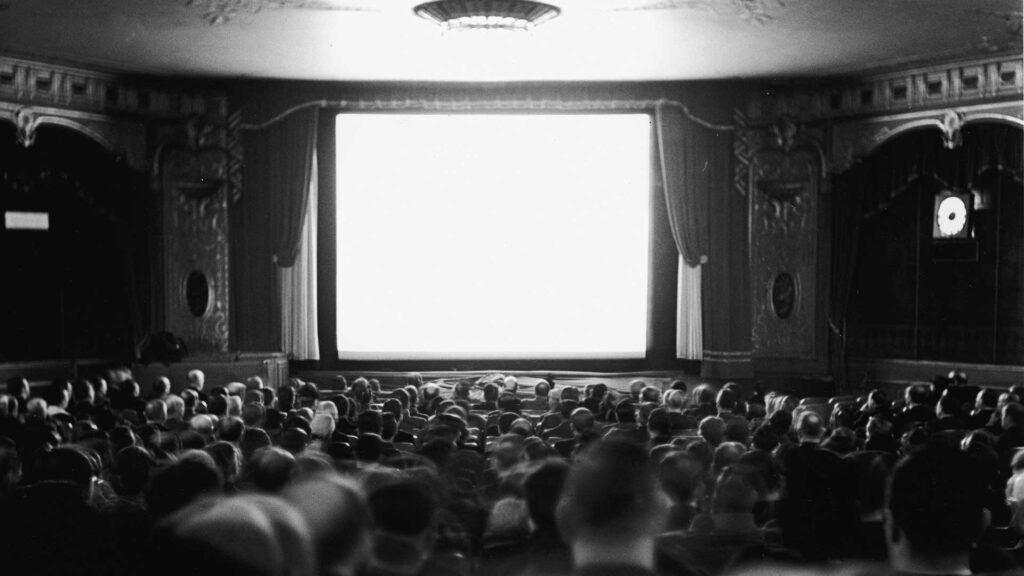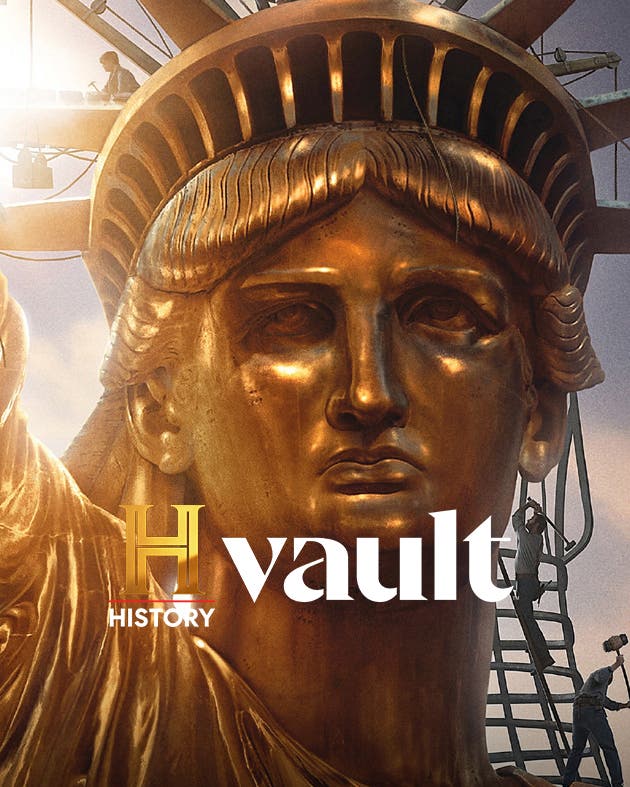At the turn of the 20th century, enterprising showmen were eager to exploit the emerging technology of motion pictures.
In fact, the very first venues for showing motion pictures in America weren’t theaters, but “amusement halls” and penny arcades. In the late 19th century, the public often got its first taste of new technologies at coin-operated parlors. In the 1890s, for example, Thomas Edison set up “phonograph parlors” where Americans paid a nickel to put on headsets and listen to some of the very first music recordings.
“The 30-year period from 1896 to 1926 is the story of a tinkerer’s technology that becomes a kind of artistic, industrial and consumer fantasy,” says Ross Melnick, a professor of film and media studies at the University of California, Santa Barbara.
Moving pictures were the next big breakthrough. The first motion picture camera was patented by French inventor Louis Le Prince in 1888, and the idea was developed further by the Lumiere brothers (Auguste and Louis) in France and Edison in America.
At first, there weren’t any projectors or screens to view the short films, which included 20-second loops of flexing strongman Eugene Sandow, a cock fight or Annie Oakley shooting her rifle. Instead, Edison and his assistant William Dickson invented a coin-operated viewing contraption called the Kinetoscope.
“They put the film inside a fairly large box that was close to chest high, and you would bend down to look at it,” says William Paul, founding director of film and media studies at Washington University in St. Louis. “You actually hand-cranked it and ran through the film, which was on an endless loop, but you could only run through it once. For a nickel, you could watch one minute of people moving as in real life. It was captivating.”
First Kinetoscope Parlor Opens
Thomas Tally’s Phonograph and Kinetoscope Parlor in Los Angeles, circa 1898.
The very first Kinetoscope parlor opened to the public on April 14, 1894, in a storefront at Broadway and 27th Street in New York City. Inside were five Kinetoscopes lined up in a row, each loaded with a different short film. For 25 cents, a patron could view all five.
For two years, coin-operated parlors and penny arcades were the only place the American public could view a motion picture, and Edison believed that individual viewing—not projection for an audience—was the future of motion picture technology. In 1895, Edison debuted the Kinetophone, another coin-operated device that paired moving pictures with recorded sound.
“I think that’s the really interesting thing about that period,” says Melnick, “because it suggests that there were two different trajectories by which motion pictures could be exhibited, and they were soon competing to be part of the consumer experience.”
America’s First Movie Theater
Although Edison was slow to embrace film projection, others weren’t. In 1895, Dickson left the Edison Company to help inventor Woodville Latham create his Eidoloscope projector. Then Dickson patented his own projector technology called the Mutoscope. When profits from Kinetoscope parlors began to wane, the Edison Company finally saw the light and bought the patent for a projector called the Phantascope, quickly renaming it the Edison Vitascope.
In 1896, Edison learned that the Lumiere brothers were planning the first American exhibition of projected motion pictures at a rented theater in New York City.
“Edison says, wait a second, we’ve got to beat them on this,” says Paul. “So he rents the Koster and Bial’s Music Hall, a popular Vaudeville theater, for the first public demonstration of the Vitascope.”
For many film historians, April 23, 1896, was the birthday of the movie theater in America. Paying spectators crowded into Koster and Bial’s theater to marvel at a series of short motion pictures projected on a small, 20-foot by 12-foot white screen.
An article in the next day’s The New York Times described the experience:
“[A]n unusually bright light fell upon the screen. Then came into view two precious blonde young persons of the variety stage, in pink and blue dresses, doing the umbrella dance with commendable celerity. Their motions were all clearly defined. When they vanished, a view of an angry surf breaking on a sandy beach near a stone pier amazed the spectators. The waves tumbled in furiously and the foam of the breakers flew high in the air. So enthusiastic was the appreciation of the crowd long before this extraordinary exhibition was finished that vociferous cheering was heard.”
Movie Theaters in the Vaudeville Era
Following the Vitascope’s successful debut, Vaudeville theaters essentially became the first movie theaters in America. At the turn of the 20th century, the Vaudeville variety show was the most popular form of mass entertainment.
“There were no purpose-built motion picture theaters in 1896,” says Melnick, “so movies were typically shown as a segment of the Vaudeville program.”
Many of the earliest motion pictures already featured Vaudeville performers—acrobats, slapstick comedians, “native” dances—so the new projection technology fit seamlessly in the typical Vaudeville program. Variety was the engine of Vaudeville, with new live acts taking the stage every 20 minutes. It made sense that the early American film industry would stick to the Vaudeville model, which was a hit with working-class audiences.
The Marx Brothers, circa 1933. From left, Leonard or Chico, Herbert or Zeppo, Julius Henry or Groucho and Adolf or Harpo.
“Every act or every short film had to be something different,” says Paul. “So if you had a comic film, then you would have a dramatic film. If you had a dramatic film, you would have a travelogue. If you had a travelogue, then you would have something about the wonders of science.”
The term “feature film” was borrowed from Vaudeville, says Paul. In a typical Vaudeville show, the “feature” act was the biggest draw—perhaps the Marx Brothers or Harry Houdini—and performed second-to-last in the program. When motion pictures became popular enough to fill that prized slot, they were advertised as the “feature” event.
“So the idea of a ‘feature film’ originally meant something of high quality,” says Paul, “and then slowly evolved to mean movies of a certain length.”
Storefront Theaters and Nickelodeons
The next evolution in American movie theaters was the rise of the storefront theaters in 1905. Vaudeville theaters were big venues designed for live performances, and a typical Vaudeville program ran for four hours. Storefront theaters essentially miniaturized the Vaudeville experience and made movies the main attraction.
“A storefront theater is a makeshift theater that takes over an existing store (maybe a restaurant or a dance hall) on a city block,” says Paul. “There’s a small box office at the entryway, seating for between 200 and 300 people, and no stage at the front, just a screen.”
The nickelodeon, popularized by Vaudeville impresario Harry Davis in Pittsburgh, Pennsylvania, was a storefront theater that charged five cents for a program of movies and live entertainment. A trip to the nickelodeon might include a sing-along (“A Bicycle Built for Two”), a comedian, a “lecture” by a traveling professor and several short movies.
“The silent movie era was like many other periods of new technology—everyone was trying new things,” says Melnick. “Film exhibitors experimented and perfected their show, especially with regards to musical accompaniment and live performance. Every exhibitor was kind of a producer/artist/showman.”
By 1910, there were more than 10,000 nickelodeon theaters in America and hundreds of short films in circulation. The popular five-cent theaters attracted more than 26 million Americans (20 percent of the total population), including a growing number of women and children.
Welcome to the Movie Palace
On April 12, 1914, an entirely new type of movie theater opened on Broadway in Manhattan. The Strand was America’s first “movie palace,” a luxuriously appointed, 3,000-seat theater designed for watching movies in comfort and style.
Palaces like The Strand offered a moviegoing first—unobstructed views from every velvet-upholstered seat in the house. It was accomplished through the construction of massive, cantilevered balconies.
“What cantilevering allowed were really big balconies without support columns,” says Paul. “The Strand held 1,500 people in the orchestra and another 1,500 in the balcony, and audiences actually found the balcony kind of thrilling.”
Radio City Music Hall, still the largest indoor theater in the world, opened as a movie palace in 1933 with seating for nearly 6,000 patrons. During the Great Depression, Americans flocked to tens of thousands of movie palaces nationwide to escape the struggles of daily life.
“Going to a movie palace—where ticket takers and ushers waited on you, where you had a beautiful bathroom and comfortable seats—offered an experience of being treated like royalty for people who toiled each day for others,” says Melnick, author of Hollywood’s Embassies: How Movie Theaters Projected American Power Around the World.
At the movie palaces, feature films would typically run for a week and a really popular movie might be “held over” for a second week. But while researching his book, When Movies Were Theater, Paul learned that when a studio wanted to promote a particularly long, expensive feature, it would “pre-release” the movie in what were known as “extended run” theaters.
Extended run theaters like the Astor in New York City were smaller spaces built for live theater. The Hollywood studios reserved these halls to charge higher prices for films before they were released to the wider public. For example, MGM showed its epic 1925 war film The Big Parade exclusively at the Astor for almost two years before distributing the movie at regular movie palaces.



